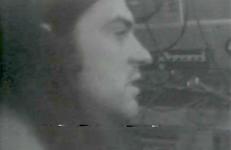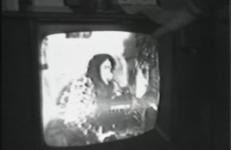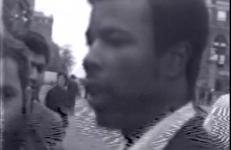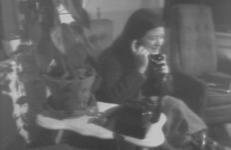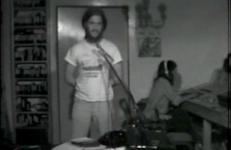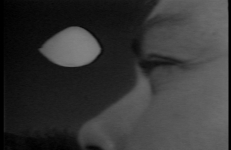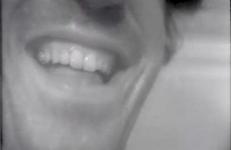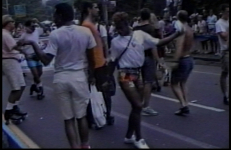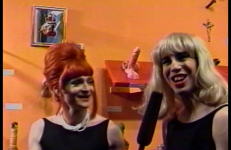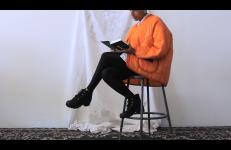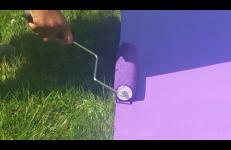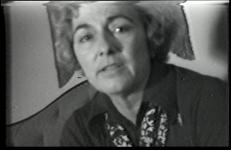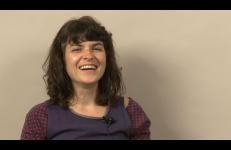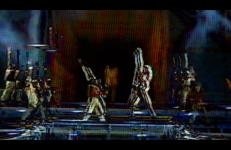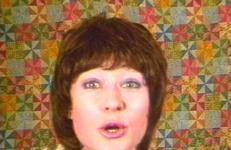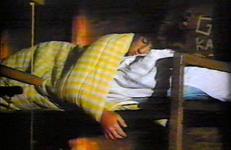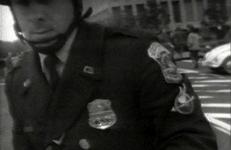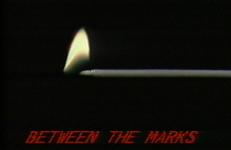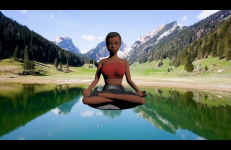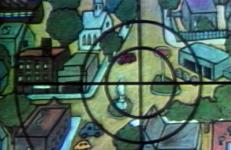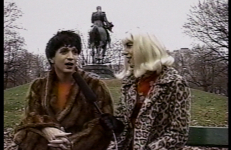Among the handful of video recordings of Lanesville TV that exist today, this tape is particularly special for its documentation of one of its very first programs to run on the air. The tape captures the energy and excitement of the Videofreex as they prepare to go live, and Parry Teasdale taking calls during the show to drum up interest and also monitor sound quality.
Television
This tape includes footage of one of the first broadcasts of Lanesville TV, as it appears on the television set of Lanesville local, Todd Benjamin, and a television set installed in a public bar. Interwoven with shots recording the program’s reception, are segments recorded for Lanesville TV itself: Bart (playing the part of “Russell”) approaches Parry, dressed as a hillbilly car mechanic “fixing” the VW Van; nearby, Nancy opens the door to a cabin, wearing a bonnet, while Carol and Chuck, crowding behind her, play the part of other Lanesville TV protagonists.
In this March 9th, 1974 episode of Lanesville TV, the Videofreex screen their recently shot ringside footage from a boxing match that took place over the weekend in Marion Square Gardens of nearby Tannersville, NY. The event, which pitted (volunteer wrestler-boxers) Frank “the Fist” Farkle of Haines Falls against Rocky Van Fight of Hunter in a match, was a fundraiser for the Rescue Squad of Tannersville.
On January 26, 1973, the Videofreex’s installment of Lanesville TV (Channel 3) consists of an interview with a follower of the Divine Light Mission, a semi-religious organization lead at the time by then-17-year-old Guru Maharaj Ji.
Although this episode promises, at first, to be a typical program of Lanesville Television—presenting two videos of previously shot footage of a truck wreck and a recent opening of a Buddhist Temple in South Cairo, NY—an unplanned event, arising mid-recording, becomes the catalyst for a high-energy, live-reportage segment.
A segment produced for radical early video collective Videofreex’s unlicensed broadcast television station, Lanesville TV, a weekly broadcast that was one of the first American pirate stations of its type. Using a DIY luma keyer by Videofreex member Chuck Kennedy to approximate a flying saucer, that was 2 affixed falsies, the group conscripted neighbors to participate in a mock news report about the “sighting”, capturing the feel of Catskills local color in the process.
In this video, the Videofreex host a party during which the main source of entertainment is a video-television feedback loop. In one room, a video camera linked up to a television set allows party guests to see themselves, as if in a mirror, while guests in the other room can also watch the recording, and may speak to them through a microphone. Although the voices of the off-screen guests can be heard on the tape, they are always imageless.
In this video, Brenda and Glennda attend and interview participants at the 1991 New York City Pride March. Speaking with a range of attendees, they underscore the significance of non-white queer communities, diverse gender and sexual identities, and political causes at pride events.
At the Lesbian Museum, Brenda and Glennda interview artists at the opening of Christine Martin’s controversial exhibition The Lesbian Museum: 10,000 Years of Penis Envy at Franklin Furnace. For the exhibition, each artist (including Brenda and Glennda) were given a dildo and asked to turn it into a work of art. The phallus, Freudian philosophy, and female criminality are discussed as a way of analyzing lesbian identity.
Sections 1-30 of an incomplete extended poem describing the artist's connection to the radical black tradition. The completed poem will be formed of 180 sections.
"Lessons are all about constraints; they are thirty seconds, must feature a black figure, and I have rules about where to make cuts, how to edit sound, etc."
— Martine Syms in conversation with Aram Moshayedi, Mousse Magazine
Sections 31-60 of an incomplete extended poem describing the artist's connection to the radical black tradition. The completed poem will be formed of 180 sections.
"Lessons are all about constraints; they are thirty seconds, must feature a black figure, and I have rules about where to make cuts, how to edit sound, etc."
— Martine Syms in conversation with Aram Moshayedi, Mousse Magazine
In October 1969, the Videofreex visited the home of wealthy political and social activist, Lucy Montgomery, as she was hosting the Black Panther Party of Chicago during one of their most fraught times — the period just after Chairman Bobby Seale was wrongfully imprisoned for inciting riots at the Democratic National Convention a year earlier. This particular video documents a discussion with Lucy Montgomery herself interviewed by David Cort, one of the Videofreex.
In this 2013 interview, experimental animator and School of the Art Institute of Chicago alumna Jodie Mack discusses the developments that have taken her from an interest in musical theater and playwriting to organizing microcinemas and DIY filmmaking.
Mack describes her interest in early cinema history and the relationship between its technologies and spectacle, particularly the manner in which video production incorporates planned obsolescence. Referring to the “scavenger nature” of her work, Mack discusses her interest in waste and her desire to use reclaimed materials in her work. Using fabric and paper to create shifting fields of color, Mack references corroded and glitched digital media in her work. Her use of quotidian materials reflects upon the role of abstract animation in everyday life, and serves to draw audience awareness to the spectacle of televisual technology.
– Kyle Riley
In the film Mad Ladders, the prophetic ramblings of an unseen narrator recount fantastical dreams of the coming Rapture, as crystalline imagery of rolling clouds gives way to heavily-processed video of moving stage sets from The American Music Awards telecasts of the 1980s and early 1990s. Blooming and pulsing in and out of geometric abstraction, this swirling storm of rising curtains, spinning set pieces, and unveiled pop idols forms an occult spectacle, driven by its impassioned narrator and an 8-bit leitmotif.
Combining Rubnitz’s skillful manipulation of the familiar “look” of TV shows with an extraordinary range of characters, performer Ann Magnuson convincingly impersonates the array of female types seen on TV in a typical broadcast day. From glitzy to drab, from friendly housewife to desperate evangelist, Magnuson is a one-woman universe appearing on every channel, the star of every program—giving her all as the chameleon woman who is always on display.
Combining Rubnitz’s skillful manipulation of the familiar “look” of TV shows with an extraordinary range of characters, performer Ann Magnuson convincingly impersonates the array of female types seen on TV in a typical broadcast day. From glitzy to drab, from friendly housewife to desperate evangelist, Magnuson is a one-woman universe appearing on every channel, the star of every program—giving her all as the chameleon woman who is always on display.
Magic for Beginners examines the mythologies found in fan culture, from longing to obsession to psychic connections. The need for such connections (whether real or imaginary) as well as the need for an emotional release that only fantasy can deliver is explored.
"Out of the blue, I bought my first television. I kept the TV on all the time."
— Andy Warhol
Meatballs - (Bill Murray + leading cast) = Marbles. A Hollywood classic re-visited and re-edited until our hero is no longer in sight.
This title is also available on Animal Charm Videoworks: Volume 2, Hot Mirror Mix.
As a verite documentation of the May 1, 1971 demonstration against the Vietnam War staged in Washington, D.C., Mayday Realtime presents a largely unedited flow of events from the point of view of participants on the street. Cort's camera captures the random, disorienting incidents that marked the day - demonstrators holding up traffic in the Capitol, skirmishes with police, on-the-scene interviews with onlookers. The camera impulsively responds to shouting and movement on the street.
As a verite documentation of the May 1, 1971 demonstration against the Vietnam War staged in Washington, D.C., Mayday Realtime presents a largely unedited flow of events from the point of view of participants on the street. Cort's camera captures the random, disorienting incidents that marked the day - demonstrators holding up traffic in the Capitol, skirmishes with police, on-the-scene interviews with onlookers. The camera impulsively responds to shouting and movement on the street.
A series of three videotape fragments (Fuse, Timer, Slow Down) presented as visual commentaries on television ads, these pieces are critical responses to the visual speed, narrative style, and format used in the making and delivering of the moving images. People producing images have been forced (for personal and public reasons) to speed up timing—time is money. This is how society builds its own schemes, structures, and culture, and how it represents them; we are consuming images as we consume food, gas, and ideas.
Meditation is from Martine Syms’ Kita’s World series. Kita enacts the performances of everyday life in a hyper-digitized world. The character’s roles range from meditation guru to cultural commentator, and she speaks directly to questions of consciousness within the systems of labor, race, technology, and institutional failure. To the cognitive dissonance of Siri mishearing her speech, to the terror of (mis)representation, to the instinct to reconnect with nature.
This surprisingly candid tape between two men looking to avoid the draft and a draft counselor offers unique entry into conversations that often only took place behind closed doors during the Vietnam War. The Videofreex capture the length of a discussion, set in an office room piled high with stacks of records and forms, during which a counselor guides two college-age men through a series of questions that they must manage and address in order to carefully navigate the legal system.
Mike Builds a Shelter is a performance comedy with apocalyptic overtones, a narrative extension of Smith's installation Government Approved Home Fallout Shelter/Snack Bar. In this darkly humorous morality play, Smith contrasts Mike's rural adventures in a pastoral landscape with his home fallout shelter. Throughout, the dual narratives are intercut with episodes of Mike's Show on cable, in which Mike's banal domestic activities are eagerly if passively received by living-room TV viewers.
In Mondo Toronto, Glennda travels to Toronto to visit Liza LaBruce (Bruce LaBruce). Liza gives Glennda a tour of the city's public parks, with specific reference to their role in gay culture. Following this, Glennda attends a party that LaBruce is hosting and interviews partygoers, including Scott Thompson from The Kids in the Hall and Amy Nitrate.




